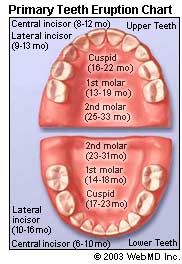Primary Teeth Development Chart
Upper Teeth When tooth emerges When tooth falls out
Central incisor - 8 to 12 months - 6 to 7 years
Lateral incisor - 9 to 13 months - 7 to 8 years
Canine (cuspid) - 16 to 22 months - 10 to 12 years
First molar - 13 to 19 months - 9 to 11 years
Second molar - 25 to 33 months - 10 to 12 years
Lower Teeth
Second molar - 23 to 31 months - 10 to 12 years
First molar - 14 to 18 months - 9 to 11 years
Canine (cuspid) - 17 to 23 months - 9 to 12 years
Lateral incisor - 10 to 16 months - 7 to 8 years
Central incisor - 6 to 10 months - 6 to 7 years
Other primary tooth eruption facts:
A general rule of thumb is that for every 6 months of life, approximately 4 teeth will erupt.
Girls generally precede boys in tooth eruption
Lower teeth usually erupt before upper teeth
Teeth in both jaws usually erupt in pairs - one on the right and one on the left
Primary teeth are smaller in size and whiter in color than the permanent teeth that will follow
By the time a child is 2 to 3 years of age, all primary teeth should have erupted
Shortly after age 4, the jaw and facial bones of the child begin to grow, creating spaces between the primary teeth. This is a perfectly natural growth process that provides the necessary space for the larger permanent teeth to emerge. Between the ages of 6 and 12, a mixture of both primary teeth and permanent teeth reside in the mouth.






